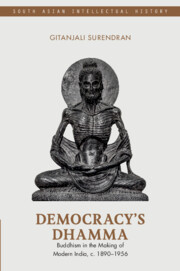Book contents
- Frontmatter
- Dedication
- Contents
- List of Figures
- Acknowledgements
- List of Abbreviations
- Introduction: Buddhism in the Making of Modern India
- 1 Anagarika Dharmapala in India
- 2 Dharmapala and Vivekananda in an Age of Universalism
- 3 Buddhism and The Bhadralok
- 4 The Buddhist Bay: Buddhist Mobility Across the Bay of Bengal
- 5 Buddhist Relics, The Mahabodhi Temple and The Discourse of a Shared Buddhism
- 6 Buddhism as a Civil Religion and Hindutva
- 7 Buddhism, Anti-Caste Radicalism and Socialism
- 8 Ambedkar, Dhamma and Democracy
- Conclusion: The Destinies of Buddhism
- Bibliography
- Index
Introduction: Buddhism in the Making of Modern India
Published online by Cambridge University Press: 28 November 2024
- Frontmatter
- Dedication
- Contents
- List of Figures
- Acknowledgements
- List of Abbreviations
- Introduction: Buddhism in the Making of Modern India
- 1 Anagarika Dharmapala in India
- 2 Dharmapala and Vivekananda in an Age of Universalism
- 3 Buddhism and The Bhadralok
- 4 The Buddhist Bay: Buddhist Mobility Across the Bay of Bengal
- 5 Buddhist Relics, The Mahabodhi Temple and The Discourse of a Shared Buddhism
- 6 Buddhism as a Civil Religion and Hindutva
- 7 Buddhism, Anti-Caste Radicalism and Socialism
- 8 Ambedkar, Dhamma and Democracy
- Conclusion: The Destinies of Buddhism
- Bibliography
- Index
Summary
In India of the 1940s and 1950s, democracy was itself the revolution. After two centuries of oppressive and unjust colonial rule and thousands of years of monarchical rule before that, the makers and thinkers of the newly minted republic thought democracy to be the appropriate political form with the possibility of peaceful revolutionary change embodied within it. After the tremendous violence of the Second World War, the spectre of the atom bombs in Japan and the brutal massacres accompanying the partition of the Indian colony into India and Pakistan, many felt it necessary to enact a peaceful revolution. Democracy was to be the means and end of that peaceful revolution. In order, however, to make sense of and to justify what seemed at first glance to be an imported political form, Indian thinkers dug deep to find native resources that could help the process of democratization of the polity. A striking solution was located in that ancient faith that was not quite separate from the universe of Hindu thought but which contained an attractive history of subversion and dissent against upper-caste Vedic religion, that heterodox 6th-century BCE sect of Buddhism. In the last century of British rule, the struggle to produce an appropriate Buddhism for a modern nation reveals a secret history undergirding the rise of the republic itself in 1950. Buddhism played its own role in the making of modern India just as both Buddhism and India were in-the-making.
In the following pages, I present to you an intellectual genealogy of Buddhism in modern India. Like all modern religions on the subcontinent, Buddhism too was reimagined and reconfigured in the 19th and 20th centuries in the context of British colonialism. In the historiography of modern South Asia, Hinduism and Islam have got the lion's share of attention. Buddhism's story is unique for the extent of its re-imagination in India, where its followers were insignificant in number and politically marginalized. A host of British and European orientalists, archaeologists and Indologists are credited with discovering ‘Buddhism’ and India's Buddhist heritage in this period.
- Type
- Chapter
- Information
- Democracy's DhammaBuddhism in the Making of Modern India, c. 1890–1956, pp. 1 - 15Publisher: Cambridge University PressPrint publication year: 2025

